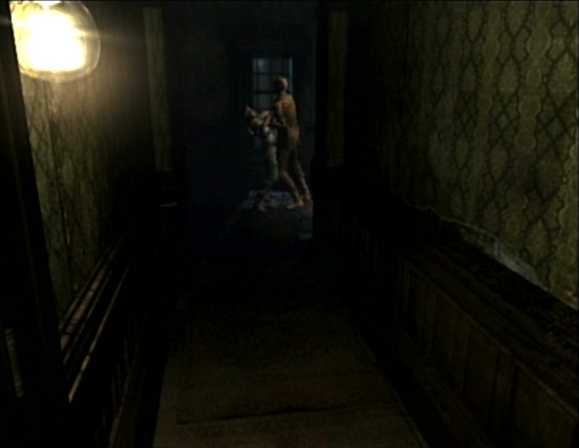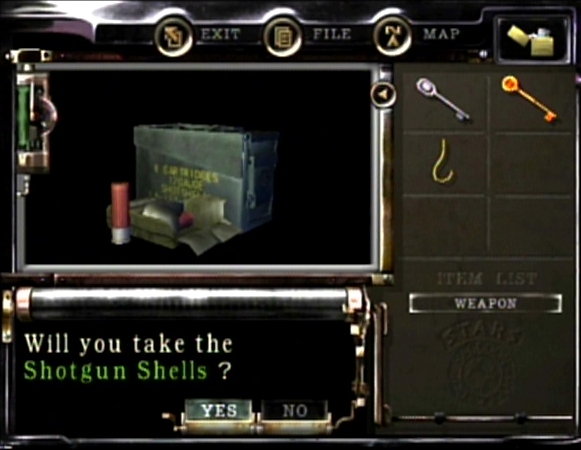Resident Evil (2002 GameCube Remake)

Resident Evil
U.S. Release Date: April 30, 2002
The GameCube Archives Score: 9.5/10
For the entirety of the Playstation/Nintendo 64 run, I had to hear about how awesome Resident Evil games were. As a Nintendo fanboy, I wanted to pretend I was too cool for Resident Evil games, but they just seemed so awesome, I'd let my Playstation-owning friends regale me of their glory for hours. When the Sony/Nintendo battle shifted to PS2/GameCube, suddenly the shoe was on the other foot. Capcom announced three Resident Evil Game's that would, at the time of their release at least, be GameCube exclusives: 2002's Resident Evil Zero, 2005's Resident Evil 4, and a 2002 remake of the original 1996 Playstation release that started it all, Resident Evil. Director, Shinji Mikami, felt that this first Resident Evil game did not graphically hold up to subsequent Resident Evil releases, but that the powerful Nintendo GameCube could remedy the situation. However, this remake would not just feature a significant graphical upgrade, but gameplay tweaks and additions, as well. But for those of us with no experience with the 1996 survival horror original, how does this 2002 Resident Evil hold up?
Resident Evil immediately draws the player in with an impressive cinematic. The player is given the choice of inhabiting either Chris Redfield or Jill Valentine, both members of a Raccoon City Police special forces unit called "S.T.A.R.S." Apparently, S.T.A.R.S. sent an elite team to investigate a series of grisly murders near the city outskirts, only to have that team disappear. Chris and Jill are part of a second team sent in to investigate the first's disappearance. After discovering the original group's crashed helicopter deep in the forest near the Arklay Mountains, the second S.T.A.R.S. team is attacked by a pack of horrific, seemingly rotting dogs. The survivors come upon and flee inside of a mysterious mansion. However, this old home is no sanctuary, but the ultimate house of horrors.
As the cinematic ends inside the mansion, the player takes control of their character, and as in all horror material, the team splits up. The player is immediately tasked with exploring the mansion's dark and foreboding hallways to find signs of the first team. In an incredible opening scare, the player discovers a member of the first team has been killed...and someone is eating them. Without further adieu, the player, armed with only a knife, a handgun and a few bullets, is face-to-face with a terrifying zombie. Hesitate for a moment, and it's chewing a hole through your neck. Fire a couple shots into it, and it falls down...only to slowly rise. The nightmare has begun.
 |
| Perhaps the most horrific first enemy encounter in any game |
 |
| From one scary angle to another. |
 |
| Doom |
This not only makes every individual screen in this game into a beautiful work of art, but incites dread, as the player can often only hear, and not see what's around the corner. Resident Evil features highly detailed pre-rendered backgrounds, populated with 3-D objects and animation. Nearly two decades later, on a CRT, these graphics still look incredible. The developers clearly studied decades of the best horror films (with Night of the Living Dead a more obvious inspiration) to inform their design and perspective choices. The back of the box touts Resident Evil as "the most terrifying, realistic video game ever created," and while the graphics aren't quite photo-realistic, in their chosen style, they're essentially flawless.
The character design is extremely impressive, as well, with both Jill and Chris, as well as enemies, feature a startlingly high amount of polygons, an incredible leap from the previous generation of consoles. The developers used motion capture, as well as mapping character faces from real-life models. Animation is also great, and though there's a stiff frame or two, the overall work is excellent for its time. Visually, few if any games from the PS2, XBox, and GameCube generation come close to this level of beauty...even if it's a grotesque and horrific beauty.
 |
| This mutant with a burlap sack over her head, attempting to beat me to death with her own manacles looks so lovely by the fireside. |
Resident Evil's control scheme was a point of contention at the time of its release. Many found the game's "tank controls" to be outdated, and the series eliminated them several years later with Resident Evil 4. However, I find that they fit this iteration of Resident Evil perfectly. The directional controls, mapped to the joystick, are essentially reverse-axis'd. While this might be confusing at first, it soon becomes intuitive, and best fits the fixed-perspective areas of the game, as the player moves around these tight 3D spaces. There is admittedly some stiffness to the controls, but that adds to the tension. The player has to hold the "R-button" to raise up their weapon. They can only aim down, straight, or up, which is a little disappointing. Perhaps this activity was not given analog-sensitivity to make headshots more difficult. Whatever the case, it's frustrating...then again, this adds to the tension, as well.
Resident Evil's mansion is laid out like a giant puzzle box. From the start, only a few rooms are accessible. The player must find keys and solve puzzles to open doors. Puzzles range from simply moving statues around, to the far more complex and arcane. Sometimes progressing means examining items in your inventory--that music box you found might have a hidden compartment, or that seemingly useless coin might be more than meets the eye. As more and more of the mansion and surrounding areas are opened, you'll find yourself having to backtrack more...which again adds to the tension. You're running down a hallway you cleared hours ago...when suddenly the windows shatter, and zombies start pouring in. You realize there's a room you didn't clear out along your route...and now you're out of bullets. Better make sure you check your map so you don't take a wrong turn.
 |
| Looking at this map and thinking of the concept, it's strange to say, but Resident Evil is kindred spirits with the previous year's Luigi's Mansion! |
Or most horrifyingly, you killed a zombie a few hours before without blowing off its head or burning it....and now it's standing up again. In perhaps the most frightening change between the original version and the remake, any unburned zombie with an intact head rises up again after several hours, as an even more aggressive and dangerous zombie called a "Crimson Head." Better make sure you load up on kerosene when you find it, so that with it and the lighter, you can burn every non-headless zombie you kill. With ammo for your weapons a scarce resource, you're not going to want to waste more on a target you already killed. You also don't want to miss in the first place, which makes every enemy encounter more nerve-wracking.
Your choice of character will weigh heavily into your strategy. Jill has more inventory spots for weapons, ammo, healing items, and other objects, meaning you won't have to spend so much time backtracking. She also has a lockpick, meaning you won't have to spend as much time collecting keys. While Jill is generally considered to be the easier character to use, especially for newcomers to this series, she doesn't fit my play style. Chris can't carry as many items, and he has a cigarette lighter instead of a lockpick, but he can also take almost twice as much damage as Jill, and can raise and fire a weapon a bit more quickly than his female counterpart. If you've read any number of my reviews, you may have picked up on the fact that given a mage, an archer, or a swordsman, I'm picking the burly warrior character every time.
With Chris, it's easier to go toe-to-toe with enemies...which include far more than just human zombies. Perhaps it's the OCD in me, but I'd rather have an easier time killing every monster in sight than an easier time avoiding them. Yes, Chris will have to backtrack more, but considering his lighter doesn't take up an inventory spot, and the one Jill finds along the way does, anyone interested in burning zombies after they kill them to prevent resurrection will only be gaining one inventory slot. The weapons available to each are also slightly different, as are their paths to the end of the game.
Thankfully, considering the limited inventory space, there are several storage boxes littered across the mansion. Going a bit against the realistic limitations you face throughout the rest of Resident Evil, you can place as many items as you want in a storage box, and access any item you've dropped in any one particular box from every item box in the game. You will generally find these item boxes in my favorite area in any Resident Evil game, the safe rooms. A safe room is a place where no enemies will ever find you. This entry contains five or six of them. They all contain a typewriter to save your game, though you'll have to find typewriter ribbons to save. This means you'll have to strategize a bit about when to save, but ribbons are generally always found close to typewriters, and thankfully aren't a very rare item--they're often found in the safe rooms themselves.
Safe rooms are a reprieve and a sanctuary from the horrors of the rest of the game. Typewriters and item boxes can sometimes be found outside of safe rooms, but you can still get attacked in those non-safe room areas. Thankfully, as with most other Resident Evil games, you'll know for sure that you're in a safe room when you hear calm, and darkly soothing music. This Resident Evil's got a great safe room musical theme, which fits perfectly overall into the game's excellent overall sound design.
Resident Evil's music verges from dark and terrifying ambient work, to peacefully reassuring pieces when you've met an ally. Sometimes, the soundtrack utilizes silence, creating dread that any sound heard will be that of impending doom. Zombie moans, footfalls on numerous different surfaces, glass breaking, guns firing, all are brought to full effect in immersive surround sound. The only flaw comes with the game's voice acting, which is not only a bit amateurish, but forced to convey some fairly lousy dialogue. While the game's overall story is slowly unfurled in a dark and frightening fashion (generally through journal entries you find throughout the mansion), the translation from Japanese to English isn't the best ever found in a game. While I'll go to bat to argue that any of Resident Evil's perceived flaws actually heighten the game's fear-factor, I can't defend the B-movie dialogue and acting. It's the game's one inarguable flaw.
In the years since the 2002 Resident Evil remake, the franchise has generally tended toward action over horror. 2005's Resident Evil 4 struck a perfect balance between the two, but most haven't been so even keeled. However, for anyone interested in experiencing this franchise at the peek of terror, 2002's Resident Evil is its frightening pinnacle.
To close, here are a bunch of pictures I took that I love, but couldn't fit in the review:
To close, here are a bunch of pictures I took that I love, but couldn't fit in the review:
 |
| Hmm...typewriter...but no "Safe Room" music. Nothing's gonna come for me here, though, right? |
 |
| That can't be good! |
 |
| Maybe don't go in there |














Comments
Post a Comment